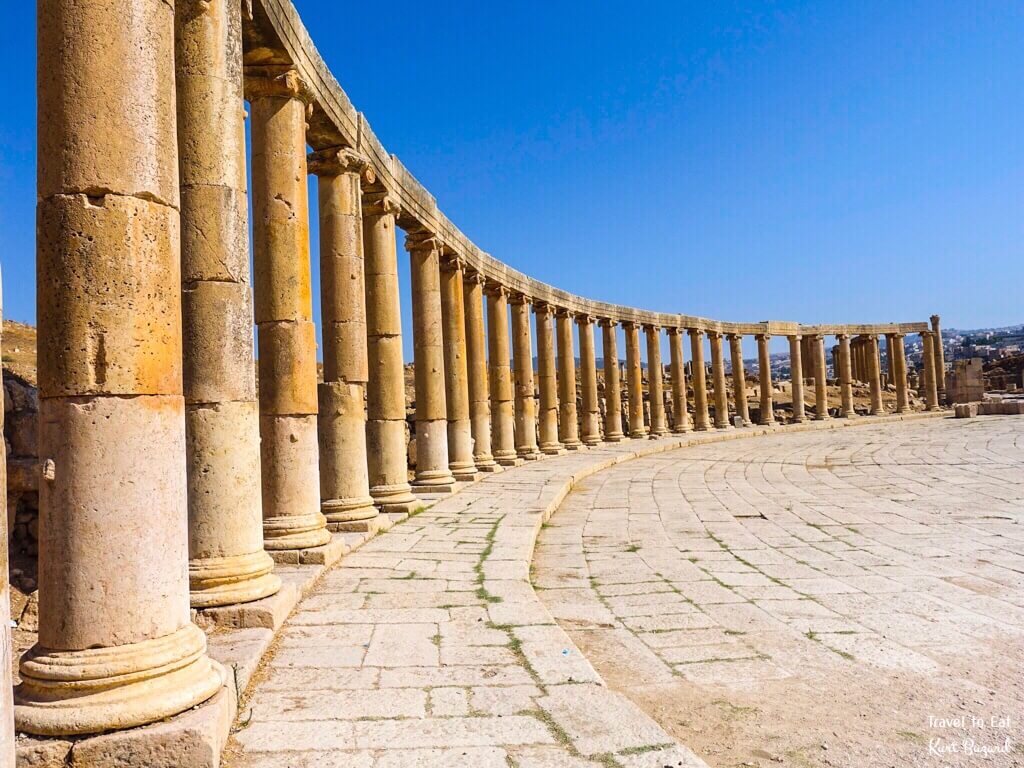
If you have ever wondered what it would be like to wander the streets of an ancient Roman city, then Gerasa (Jerash) might be the place for you. Jerash is the site of the ruins of the Greco-Roman city of Gerasa, also referred to as Antioch on the Golden River. Ancient Greek inscriptions from the city as well as literary sources from both Iamblichus and the Etymologicum Magnum support that the city was founded by Alexander the Great or his general Perdiccas, who settled aged Macedonian soldiers there. The city finally reached a size of about 800,000 square meters within its walls. The Persian invasion in AD 614 caused the rapid decline of Jerash. In AD 749, a major earthquake destroyed much of Jerash and its surroundings.The ruins remained buried in the soil for hundreds of years until they were discovered by German Orientalist Ulrich Jasper Seetzen in 1806. In addition to the role of the people of old villages near Jerash, the process of building the modern city of Jerash was mainly done by the resettlement of Circassian Muslims by the Ottoman authorities; the Circassians came to Transjordan from the Caucasus after the Russo-Turkish War of 1877–78.
Hadrian’s Arch
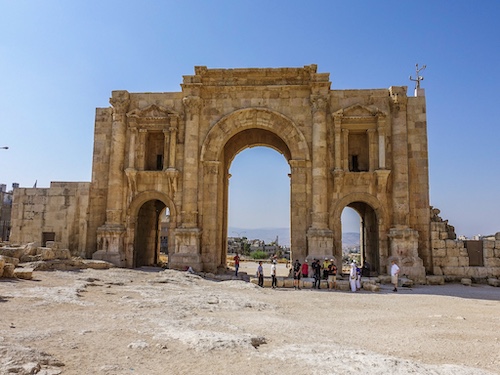

The city expanded in the 2nd century as far south as Hadrian’s Arch. Hadrian was called the “flying emperor” because he spent most of his time traveling to cities around the empire. This arch was built about AD 130. The central gate was apparently only used for important visitors. The niches on either side were for statues.

The first travelers to visit the ruins of Gerasa at the start of the 19th century described the site as completely deserted but dangerous, as it was subject to Bedouin raids. From 1875, groups of Circassians and Chechens were moved to different points of what was then a province of the Ottoman empire. Amman, Salt and Jarash were thus repopulated. In Jarash, the colonists settled mostly on the east bank of the wadi where they founded a new village that became the ancestor of the modern town. They built their constructions using stone blocks, some of which were decorated, taken from the ancient monuments on the west bank, which at that time was considered as no more than a source of building materials. To protect and monitor the new arrivals, the Ottoman authorities installed a small garrison here, and this building was built around 1910 on one side of the Propylaea of the Temple of Artemis to house the soldiers.
Hippodrome
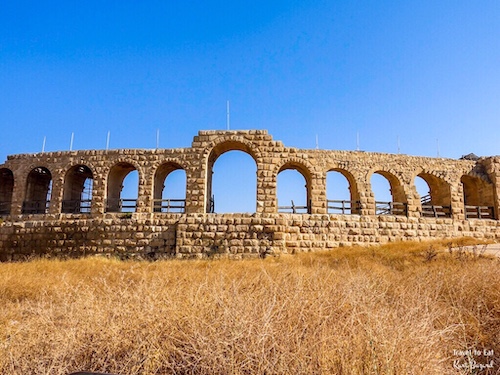

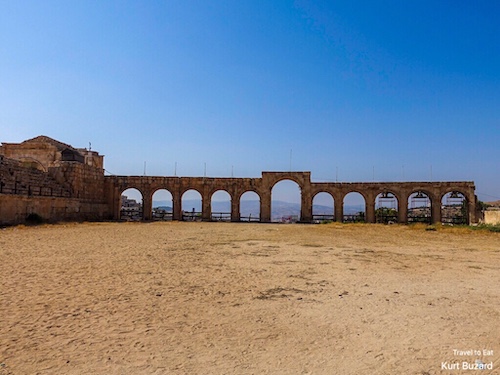
When Hadrian’s project to expand the city over the south necropolis was abandoned, the western side of the Gerasa/Philadelphia road was free to build this hippodrome (which means “circus” in Latin). It is the smallest known hippodrome of the Roman Empire, and also the best preserved; particularly the arched carceres, which are the starting gates where the horses would be positioned. Built for chariot racing, it was 265 meters long (869 feet) and 50 meters wide (164 feet). The monument was probably completed in the early 3rd century and it could accommodate up to 17,000 spectators. However, it is uncertain as to whether the track was actually ready for use, allowing competition between the “reds”, “greens”, “blues” and “white”, which were the colors worn by competing teams. By the late 4th century the northern part of the hippodrome had been transformed into an amphitheater for gladiator fights and other sports, while the south part was abandoned and squatted on by potters. Between the 6th and 8th centuries this monument was used as a quarry, with materials taken to repair the city walls. At the same time, artisan dyers reused part of the ruins as workshops. In the 8th century the area became the site of mass graves for the hurried burial of hundreds of victims of a plague. It was the great earthquake of 749 AD that led to the final ruin of the Gerasa hippodrome.


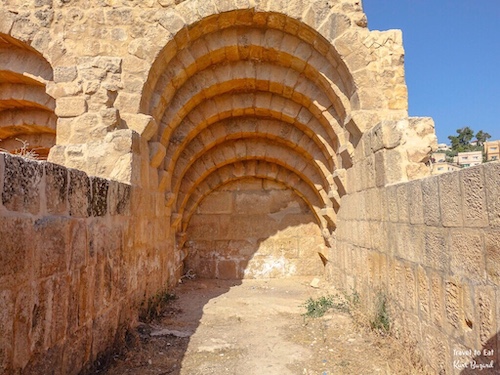
Since 1981, the old city of Jerash has hosted the Jerash Festival of Culture and Arts, a three-week-long summer program of dance, music, and theatrical performances. The festival is frequently attended by members of the royal family of Jordan and is hailed as one of the largest cultural activities in the region. In addition performances of the Roman Army and Chariot Experience (RACE) were started at the hippodrome in Jerash. The show runs twice daily, at 11am and at 2pm, and at 10am on Fridays, except Tuesdays. It features forty-five legionaries in full armour in a display of Roman army drill and battle tactics, ten gladiators fighting “to the death” and several Roman chariots competing in a classical seven-lap race around the ancient hippodrome.
South Gate
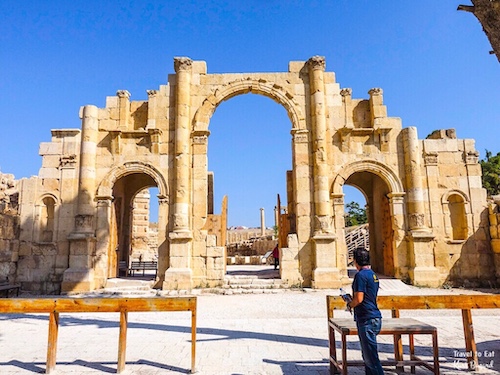
We entered the main city through the South Gate of Gerasa. Approaching the city from the Visitor’s Center, you see the impressive city walls, built at the beginning of the 4th century, most probably by Emperor Diocletian, and repeatedly expanded afterwards. The present walls are Byzantine and had a total length of 3456 m. The South Gate through which you enter Jerash, dates from 130 AD and has a characteristic carved acanthus-leaf decoration. The open area inside the gate was used as a marketplace, and a 2nd century olive press is visible behind a wooden screen.
Map of Gerasa of Antiquity
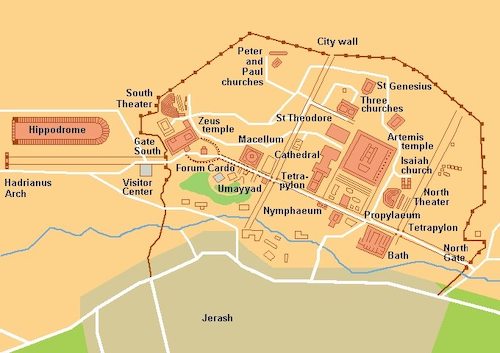
Oval Plaza
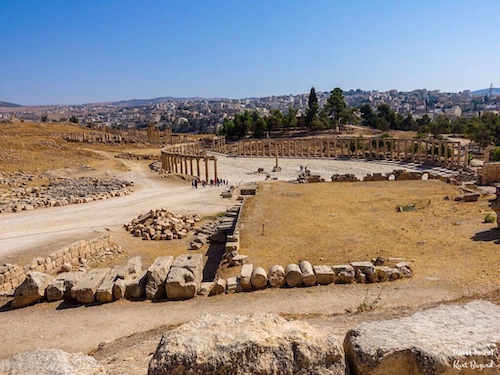
The size of Gerasa as an archeological site is simply enormous. Jerash is sometimes misleadingly referred to as the “Pompeii of the Middle East” or of Asia, referring to its size, extent of excavation and level of preservation, since Jerash was never destroyed and buried by a single cataclysmic event, such as a volcanic eruption. Jerash is considered one of the most important and best preserved Roman cities in the Near East. According to “Jordan Times”, the number of tourists who visited the ancient city of Jerash reached 214,000 during 2005. Director of Jerash Antiquities Department Mohammad Balawneh said that the number of non-Jordanian tourists was 182,000 last year. This makes it the second most visited site in Jordan after Petra.
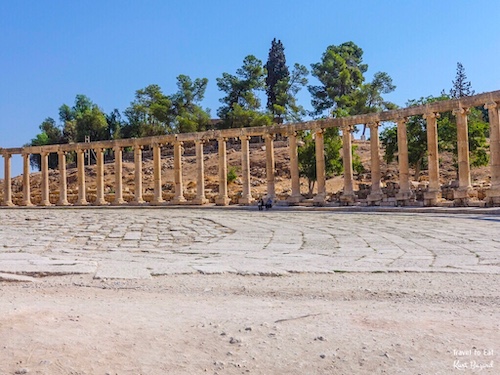
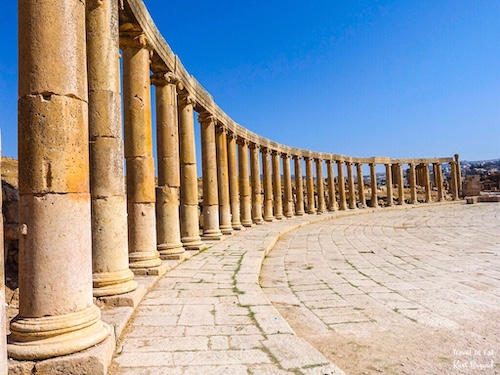
A cardo was the Latin name given to a north-south street in Ancient Roman cities and military camps as an integral component of city planning. The cardo maximus was the “hinge” or axis of the city, derived from the same root as cardinal and as such was generally lined with shops and vendors, and served as a hub of economic life. Most Roman cities also had a Decumanus Maximus, an east-west street that served as a secondary main street. Due to varying geography, in some cities the Decumanus is the main street and the Cardo is secondary, but in general the cardo maximus served as the primary street. The Forum was normally located at, or close to, the intersection of the Decumanus and the Cardo. In Gerasa the forum was an immense Oval Plaza. The spacious plaza measures 90 x 80 m and is surrounded by a broad sidewalk and a colonnade of 1st century Ionic columns. There are 2 altars in the middle, and a fountain was added in the 7th century AD. This square structure now supports a central column, which was recently erected to carry the Jerash Festival flame.
Temple of Zeus
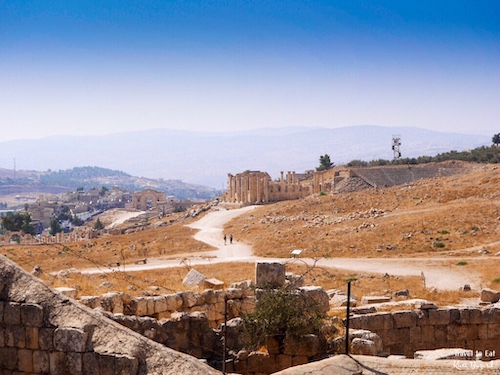

Erected in 162 AD, this temple stands on ruins of earlier sacred sites. From the Oval Plaza, a staircase leads up to an esplanade (in front of the temple), which was a Temenos, or sacred precinct. Originally, a rock in the esplanade served as a high place, and was enclosed into a shrine (Naos) in 100-80 BC.This shrine was modified in 69-70 AD and in the 2nd century AD, probably under Emperor Hadrian. From there, another staircase led to the temple, which was originally surrounded by 15 meter (50 feet) high Corinthian columns.
South Theater
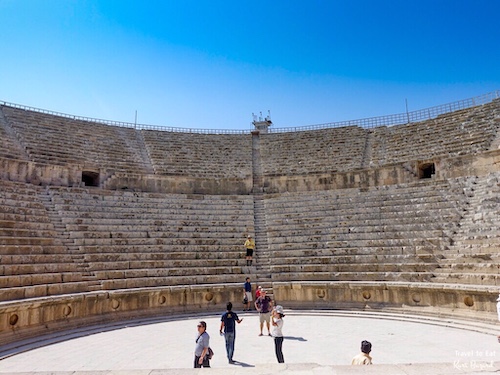
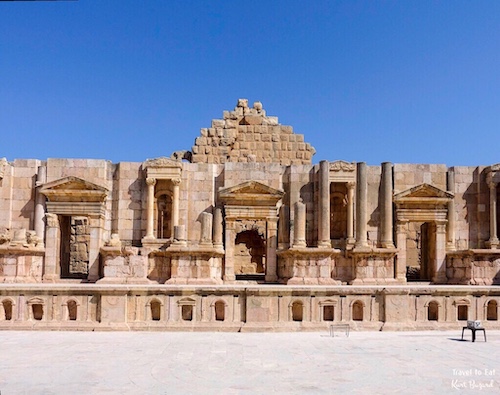
Built during the reign of Emperor Domitian, between 90-92 AD, the North Theater seats more than 3000 spectators and serves today as the primary venue for the Jerash Festival of Culture and Arts. The first level of the ornate stage, originally 2-stories has been reconstructed and is still used today. The remarkable acoustics allows a speaker at the center of the orchestra floor to be heard by the entire auditorium without raising his/her voice. In 235 AD, the theater was doubled in size to its present capacity of 1600. Two vaulted passages formed the entrance to the orchestra, and spectators entered through passages between the upper rows of seats. The theater fell into disuse in the 5th century, and in later centuries, many of its stones were taken for use in other buildings.
Cardo Maximus
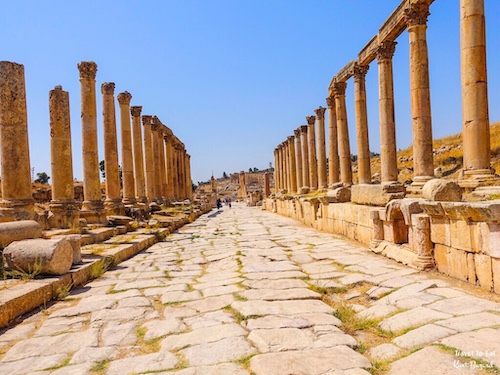

Still paved with the original stones – the ruts worn by chariot wheels still visible – the 800 meter (2625 feet) Cardo was the architectural spine and focal point of Gerasa. The colonnaded street was remodeled in the late 2nd century AD, probably after 170 AD. The Ionic columns were replaced by more elaborate Corinthian columns. On either side was a broad sidewalk with shops, which can still be clearly seen. An underground sewage system ran the full length of the Cardo, and the regular holes at the sides of the street drained rainwater into the sewers.
Procession to the Temple of Artemis
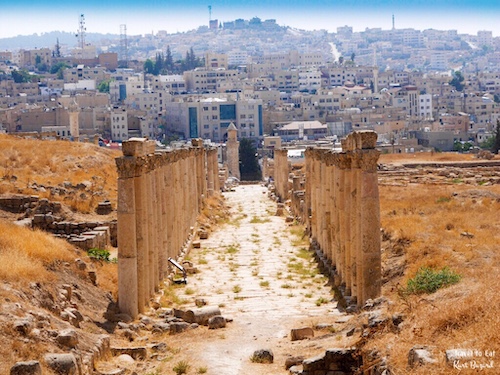
The procession to the Temple of Artemis originally started across the river in the part of Gerasa now covered by modern Jerash. Crossing the Cardo, worshippers approached the impressive entrance to the processional way leading up to the Temple of Artemis. Its massive columns and a carved portico were flanked by 2-story shops.
Monumental Staircase to the Temple of Artemis
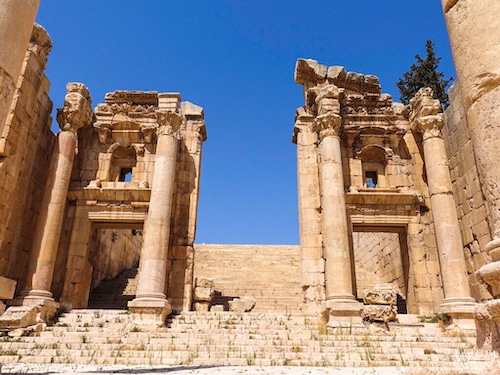
The monumental staircase, originally enclosed by high walls, leads up to a U-shaped terrace where an open-air altar was built, the foundations of which are still visible. A second staircase leads through a colonnade of 22 Corinthian columns and into the Temenos. This sacred precinct, 162 x 121 m, was defined by Corinthian columns on all 4 sides.
Temple of Artemis
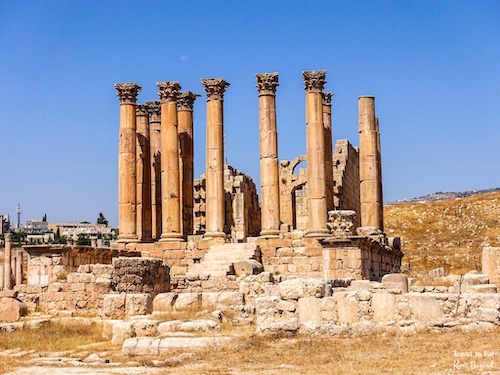

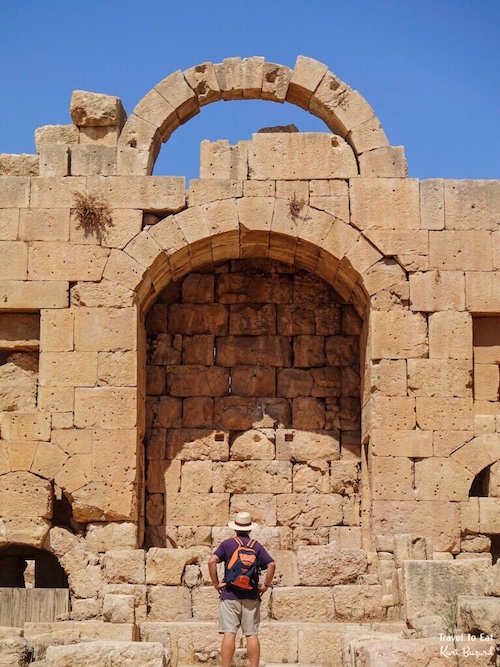
This temple was built as a shrine to Artemis, who was the patron goddess of Gerosa. It lies inside the large courtyard of the sanctuary. Construction of the temple began in the 2nd century AD, however it was never finished and only 12 columns out of a planned total of 32 were erected.The temple sits on an extensive system of underground vaults, the exact purpose of which is not known. At the back is an adytum, or an inner shrine, where only the Roman priest would be permitted. It comprises a niche for a deity and two side chambers. One of the chambers has a staircase leading down to the vaults, while the second has a staircase leading up to the roof, indicating that there may have been an altar on top. The temple was used in later times as well, possibly as a church in the Byzantine era, by potters during Umayyad times and in the 12th-century it may have been used as a fort by a group of Crusaders.
Sanctuary of Artemis

After the East Baths, the sanctuary of Artemis is the largest monument in Gerasa. A temple stands inside the large courtyard that measures 115 by 155 meters and is surrounded by porticoes on all four sides, a typical “Syrian” plan for a sanctuary. The approach to the temple and its sanctuary would have been quite awe-inspiring. It is perched on a hill at the center of the town, at a tangent to the Cardo. Looking up from the bottom, worshippers would not yet be able to see the temple. To reach it they would undertake a grand ascent, which began at the Cardo facing a monumental propyloeum, or entryway. Beyond this was a large flight of steps that widened at the next level. At the end of the steps was a portico with beautifully decorated columns and facade and beyond this gate lay the courtyard and the Temple of Artemis. There is no proof at the sanctuary or temple that this was a sacred place or one of worship prior to 135 AD when planning began for this structure. It is likely that the sanctuary was constructed on the site of an earlier necropolison the orders of Hadrian. Abandoned from the mid-5th century, it was turned into a quarry and was occupied by potters during the Umayyad epoch.
Nymphaeum
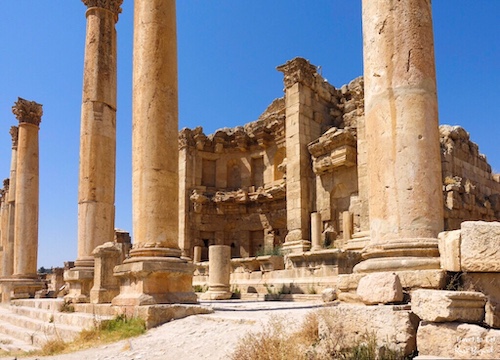
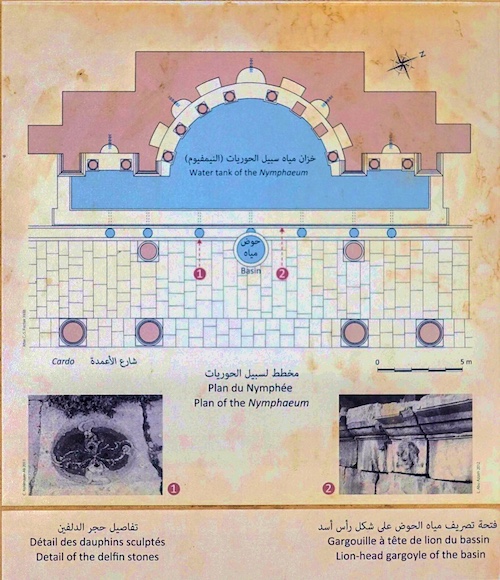
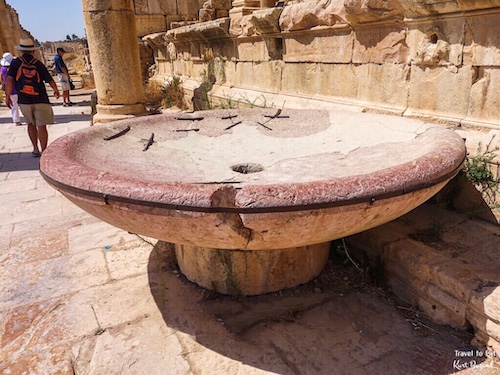
This ornamental fountain was constructed in 191 AD, and dedicated to the Nymphs. Such fountains were common in Roman cities, and provided a refreshing focal point for the city. This fine example was originally embellished with marble facings on the lower level and painted plaster on the upper level, topped with a half-dome roof. Water cascaded through 7 carved lions’ heads into basins on the sidewalk and overflowed from there through drains into the underground sewer system.
Entrance to the Cathedral Church Complex
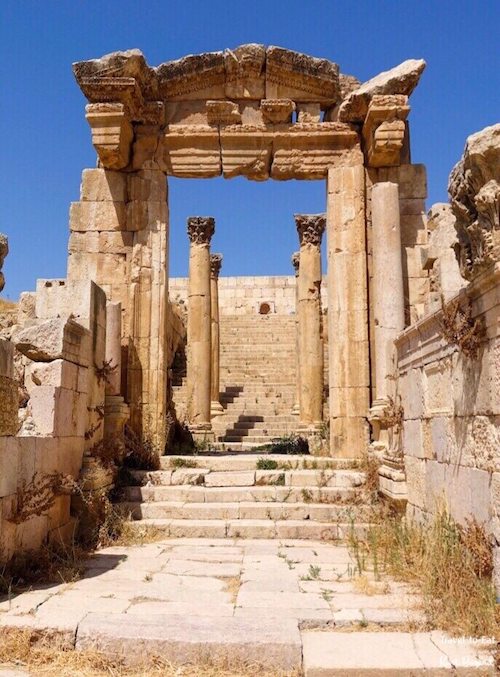
This is the oldest known Byzantine church in Gerasa/Jarash and was probably built around 450/455 AD when the bishop of Gerasa was Bishop Placcus. The site was previously occupied by a pagan sanctuary, perhaps dedicated to Dionysos, the god of wine. During his reign Bishop Placcus dismantled the Temple of Zeus and used some of the stones for this church, as well as to build the nearby baths named after him. This church was dubbed “the Cathedral” by the American excavation team that unearthed it in 1929. The wonderful architecture of the Cathedral is still apparent in what remains today. The main entrance to the church is on the west side, from an atrium called the Fountain Courtyard. Eight other entrances also allowed access to the church and inside the space is partitioned into three sections by two rows of columns with an apse at the front of the church that only the priest would have access to.
North Theater
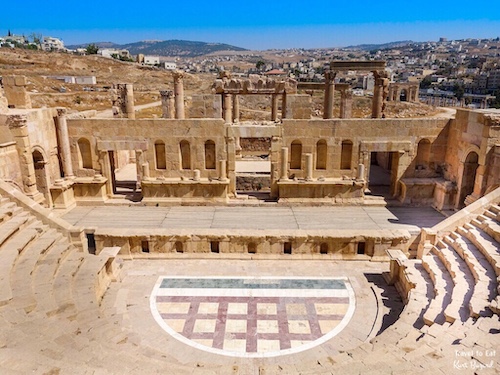
Just off the North Decumanus, the North Theater was built in 165 AD. It was originally built during the reign of Marcus Aurelius (161-180 AD) as the city’s council chamber, and later enlarged. Seating was allocated by political and religious castes (phylai). In front is a colonnaded plaza where a staircase led up to the entrance. The theater originally had only 14 rows of seats, and was used as a performance stage as well as the city council chamber; the names of the tribes represented in the council are inscribed in Greek on some of the seats, along with those of several gods.
North Gate, Cardi and Tetrapylon
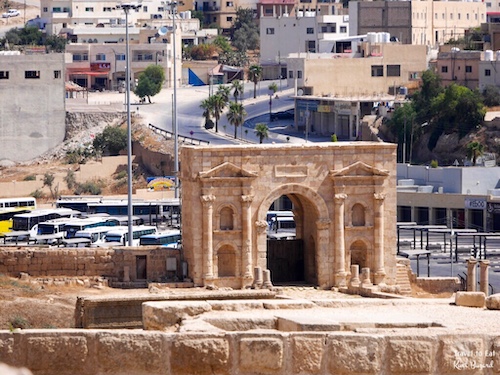
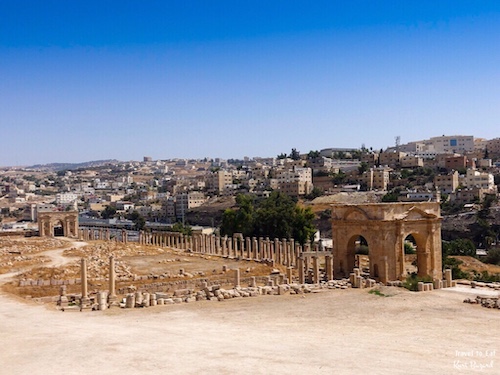
The north Tetrapylon, located where the North Decumanus or cross street intersects the Cardo, was built during Jerash’s redesign, probably as a monumental entrance to the North Theater. At a later date, it was dedicated to Julia Domna, the Syrian wife of Emperor Septimius Severus, and probably had a domed roof in the 2nd century AD, elaborate carved decoration, arches and 4 sides to allow traffic to pass through. At the end of the Cardo, the North Gate was built in 115 AD. Its odd wedge shape was probably necessary to align the gate on the inside with the Cardo, and on the outside with the Roman road, which led north to the Decapolis city of Pella.
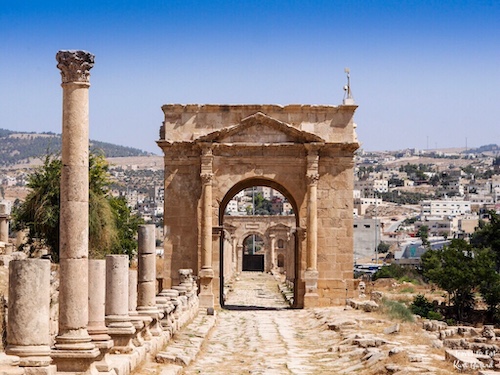
I hope you enjoyed this introduction to ancient Gerasa, it is a fascinating place to visit, especially during the Jerash Festival of Culture and Arts. As always, please leave a comment.
[mappress mapid=”208″]
References:
Gerasa: http://www.bibleplaces.com/gerasa/
Gerasa: https://www.ministrymagazine.org/archive/1958/02/with-paul-in-athens
Atlas Tours: http://www.atlastours.net/jordan/jerash_map.html
Sent from my iPad

